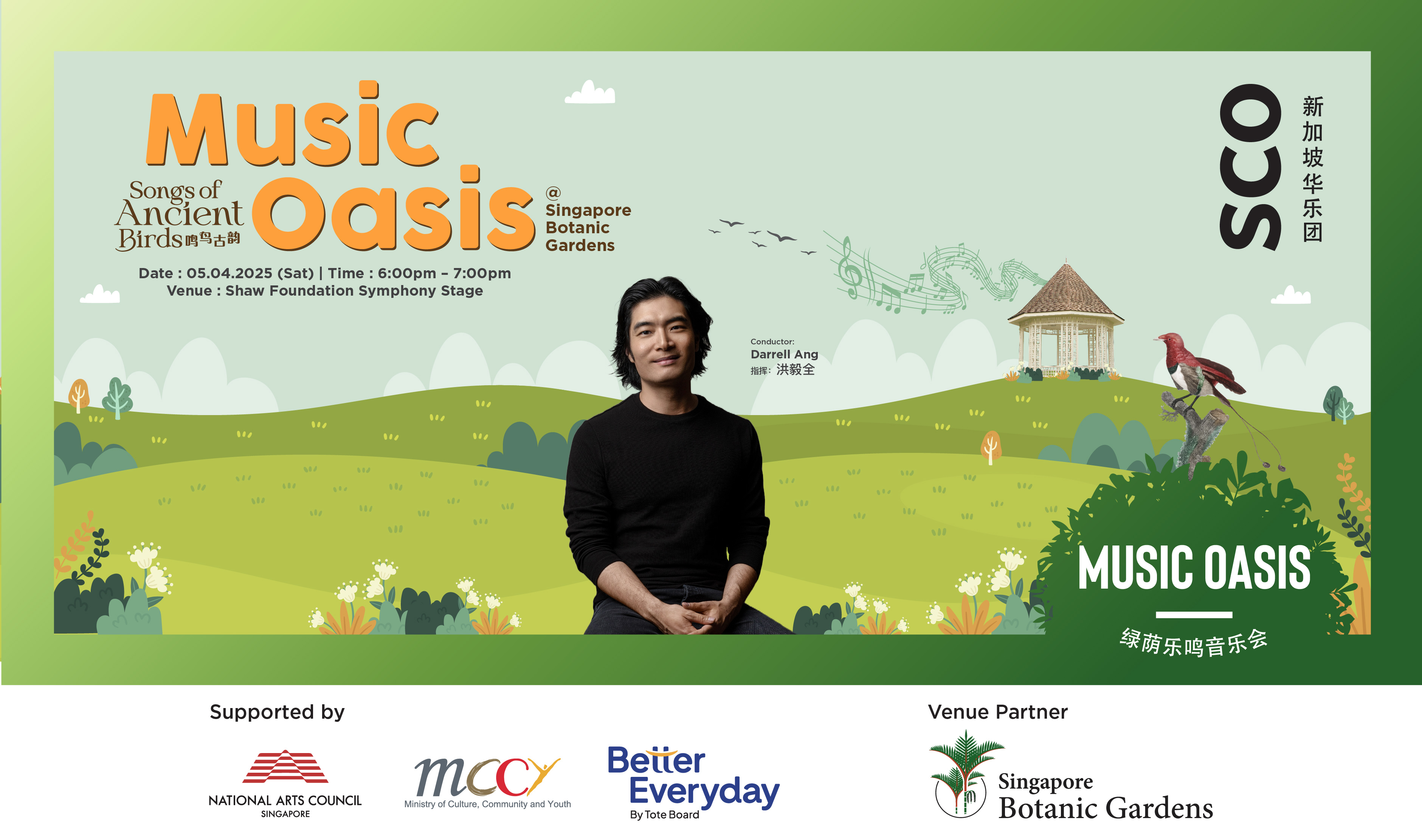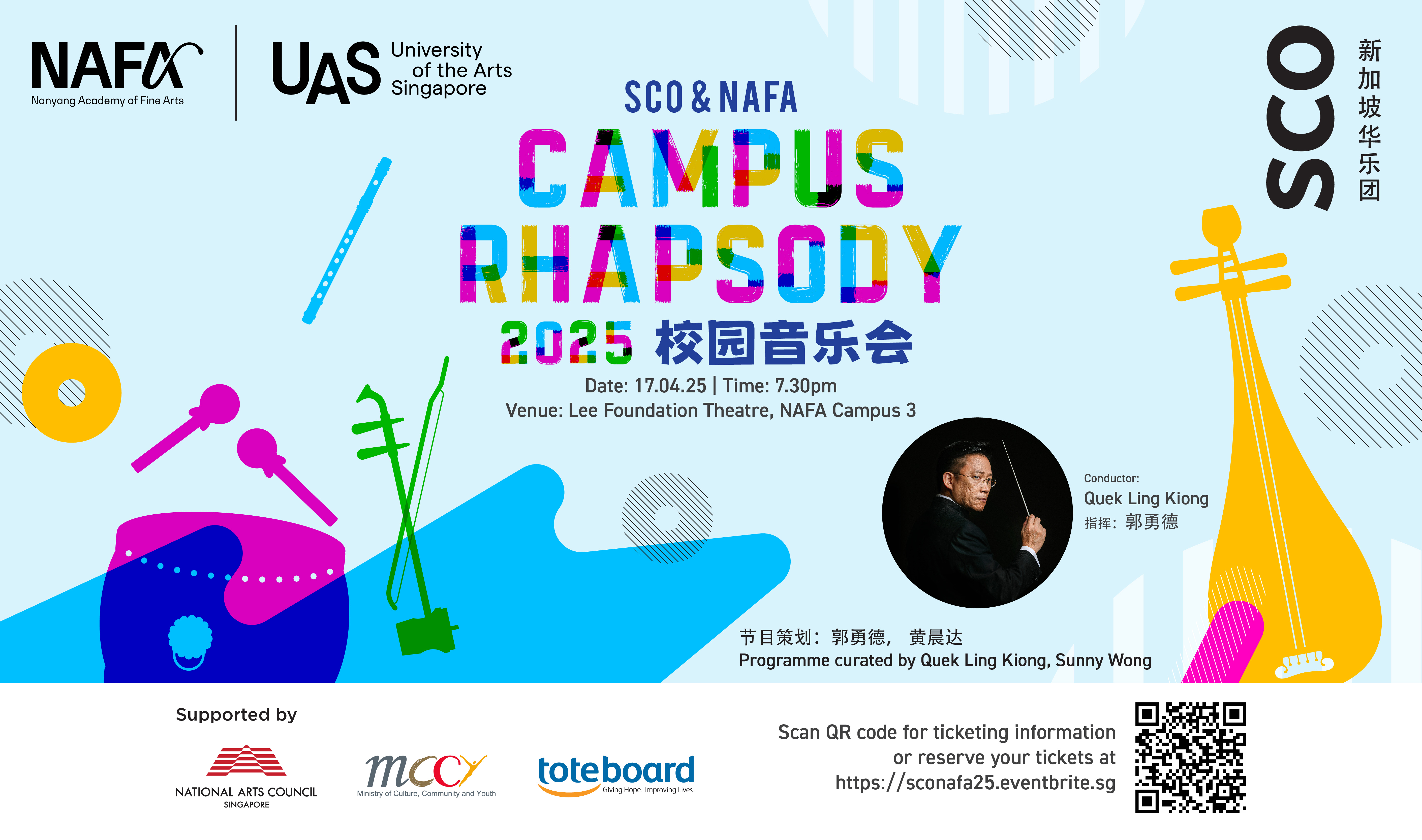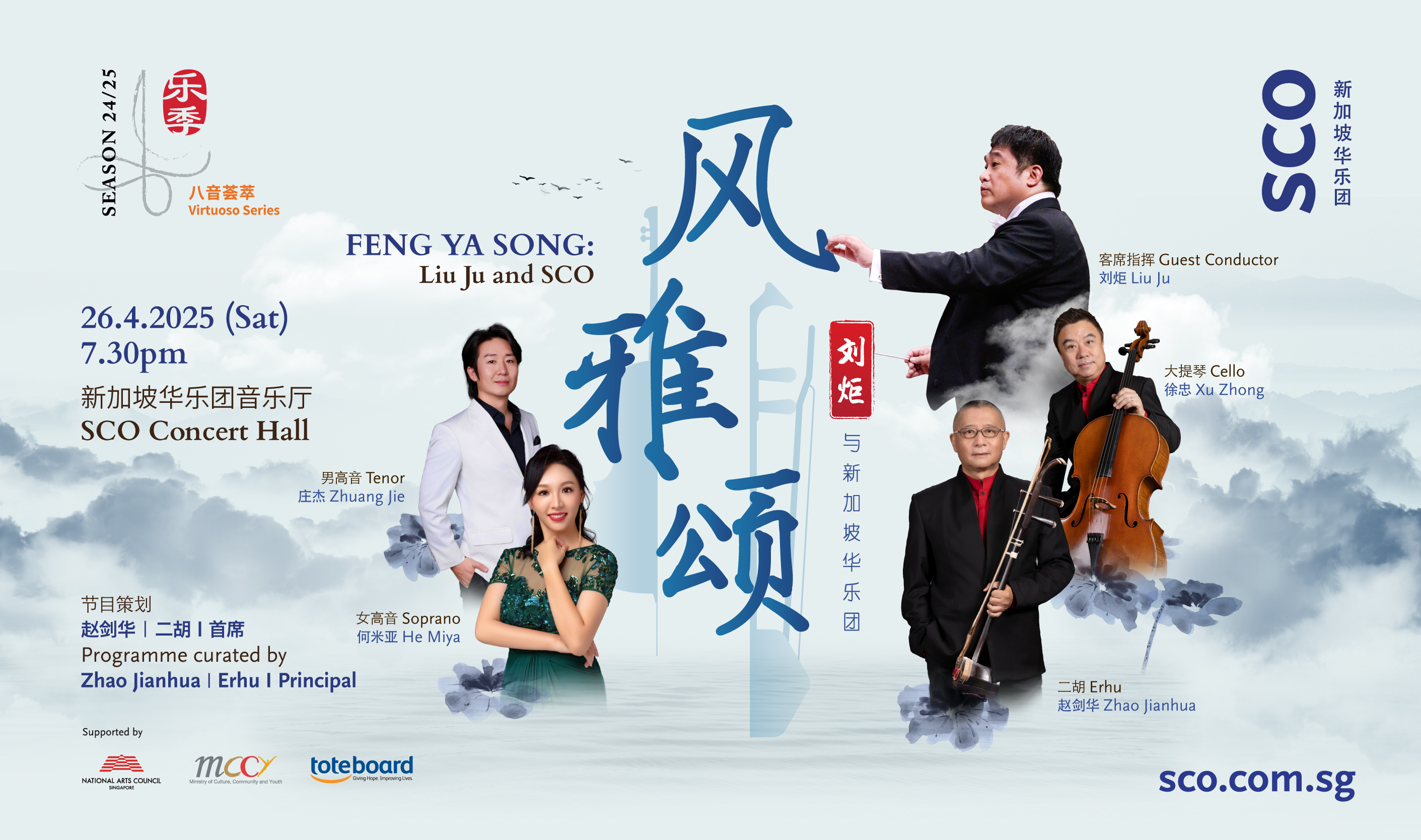Concert Season 24/25 Master Series 乐季 24/25 大师风采
By Jon Lin CHUA
In this programme carefully curated by Maestro Tsung Yeh and featuring three Singapore premieres, both the audience and the orchestra are challenged to move beyond their comfort zones with the introduction of new repertoire. Yeh, who served as the Music Director of the SCO from 2002 to 2023 and was subsequently appointed as the orchestra’s Conductor Emeritus, has undeniably played a pivotal role in leading the orchestra in breaking new ground and in scaling greater heights, while also greatly opening up the pool of Chinese orchestral repertoire. Naturally, in this concert, the audience can look forward to being stimulated by new and exciting music that has not been heard on these shores, while being assured of the high quality of music that is always promised by Yeh.
Nevertheless, despite the introduction of new repertoire, the subject matter and musical material of many of these pieces are derived from familiar Chinese folk sources. Li Bochan’s Dukezong takes inspiration from the highly rhythmic bonfire ritual dances of the Naxi and the Tibetan tribal people; Kong Zhixuan’s Tone Poem of Wuxi incorporates the gentler and more lyrical folk styles of jiangnan sizhu and Suzhou tanci from the Suzhou and Hangzhou region; Lu Yun’s rousing Lang Sai revives the traditional Chinese festive custom of lion dance; Liu Qing’s theatrical Sha Wei is based upon a specific rhythmic gesture from traditional Chinese opera percussion; Wang Danhong’s rhythmic Strings on Yangko Dance borrows modal melodies from folk yangko dance, which originated from rice seeding and harvest activities; and Jia Daqun’s dramatic Rhapsody - The Spirit of the Tunes from Shaanxi Opera is steeped in the idiom of Northwestern China with influences from the Northwestern folk music genres of xintianyou, hua’er, qinqiang, and yaogu. It is also worth mentioning that Wang Danhong’s Strings on Yangko Dance has been performed before by the SCO under Yeh’s baton, and is thus not a new piece on the programme. Yet, it still remains a very technically and rhythmically challenging piece for the orchestra today.
Taking centrestage along with Yeh and the orchestra is suona soloist Liu Wenwen, who presents not only one concerto as per usual concert conventions, but two major concertos which are rather contrasting in character. Through this unique programming of two vastly different concertos on the same concert, Yeh intends to showcase her versatility as a musician and her ability to deftly navigate different musical styles, techniques, and modes of expression. While Jia Daqun’s Rhapsody features intense and plaintive songlike suona melodies with wide leaps, heavy vibrato, and large slides along with other dramatic musical gestures as typical of traditional Northwestern Chinese folk song styles, Lu Yun’s Lang Sai features the solo suona as a musical depiction of a traditional Southern Chinese lion dance lion in its various gestures and motions, thus taking on a more theatrical mode of expression. The musical languages of the suona parts in both pieces differ considerably, along with the techniques used, fully allowing the soloist to display her virtuosity in hugely different ways.
Another unique point within this programme of predominantly large orchestral pieces is the inclusion of Liu Qing’s Sha Wei, which features a far smaller chamber group of nine musicians. Yeh has thoughtfully included this piece in the middle of the programme in order to provide the audience with a refreshing change in sonorites, as well as to showcase some of the orchestra’s non-principal musicians who are similarly outstanding in their craft. Despite the difference in musical style and sonority, this piece remains very much consistent with the rest of the programme in terms of its folk-derived subject matter. Despite featuring a reduced instrumentation as compared to the rest of the programme, this piece is no less dramatic nor impactful; its range of expression is just as broad, if not broader, with each instrument in the ensemble being able to fully unleash its unique instrumental colour and timbre.
Yeh is mindful of alternating highly rhythmic pieces such as Li Bochan’s Dukezong and Wang Danhong’s Strings on Yangko Dance with more lyrical pieces such as Kong Zhixuan’s Tone Poem of Wuxi. With musical material borrowed from the rhythmic folk dances of the Naxi and Tibetan tribes, Li’s Dukezong prepares the audience for Lu Yun’s suona concerto in the first half of the programme. Kong’s gentler Tone Poem of Wuxi mitigates some of the high rhythmic tension rife in the first half of the programme with the melodious musical elements of jiangnan sizhu and Suzhou tanci. Wang’s Strings on Yangko Dance fully showcases the orchestra’s technical and musical prowess, complementing the virtuosity displayed by the suona soloist on the programme.
Despite the common theme of folk music elements throughout the entire programme, the diverse palette of composers featured span across young, veteran, male, and female, and across rather even proportions. Along with the different musical styles and folk music elements featured, the audience may look forward to an aural feast under the baton of Maestro Tsung Yeh.
蔡宗玲 / 撰文
这场音乐会由乐团荣誉指挥叶聪精心策划,节目中包括了三部新加坡首演的作品,挑战观众和乐团的舒适区,同时也为乐团开拓新的曲目。叶聪在2002年至2023年期间担任新加坡华乐团的音乐总监,随后被委任为乐团的荣誉指挥。他带领了乐团开辟新天地,攀登更高峰,同时也大大地丰富了华乐团曲目的库藏。在这场音乐会中,观众亦可以期待通过叶聪指挥棒下一贯保证的高质量,聆听到从未在本地演出过的作品。
尽管是新曲目,此音乐会上所有作品的主题和音乐素材仍源自于熟悉的民间因素。李博禅的《独克宗》受到了纳西族与藏族的篝火祭祀舞的启发;孔志轩的《梁溪音诗》融合了江南丝竹和苏州弹词的柔及抒情的风格;陆枟热烈的《弄狮》通过音乐描绘了中国传统的舞狮节庆习俗;刘青戏剧性的《煞尾》借鉴了中国传统戏曲锣鼓中的音乐素材;王丹红节奏感极强烈的《弦上秧歌》采用了中国北方秧歌舞的元素;贾达群的戏剧性《狂想曲·梨园腔魂》深深植根于中国西北的民间音乐风格,如信天游、花儿、秦腔及腰鼓等等。此外,《弦上秧歌》也曾在叶聪的指挥下由新加坡华乐团演出过,因此对本地观众而言也不算是新曲目。然而,这首曲子至今对乐团来说无论是在技术上或是节奏上仍具挑战性。
与叶聪和乐团同台演出的还有唢呐独奏家刘雯雯。她并没按照音乐会上的常规惯例只演奏一首协奏曲,而是在音乐会的上下半场上演奏两首截然不同的协奏曲,充分地展示着她对于不同音乐风格、技巧及表达方式娴熟的驾驭能力。贾达群的《狂想曲》富于浓郁的西北音乐风格,其中包含着大量如歌如泣、高亢的唢呐旋律,技巧上以及音乐表达上幅度极大;而陆枟的《弄狮》则通过唢呐独奏生动地描绘了传统南方舞狮中的各种姿态和动作,采用了较为戏剧化的表现方式以及一些非传统技巧。这两部作品中的音乐语言和技巧迥然不同,充分展示了独奏家的多样化的音乐能力。
这场音乐会上主要以大型管弦乐作品为主,而刘青的《煞尾》是一首只有九位音乐家演奏的室内乐团作品,在这场节目中也成为个独特的亮点。叶聪在节目中段做了这样的安排,旨在为观众提供一些新鲜的音色变化,同时也展示乐团中一些非首席但同样出色的音乐家。尽管音乐风格和音色与音乐会上其它曲目有所不同,这部作品在题材上与其余作品都一样源于民间素材。虽然乐团编制较小,这部作品的戏剧性和影响力丝毫不减,让当中的每件乐器都能充分发挥其独特的音色和特质,具有丰富的表现力。
叶聪巧妙地在节目中交替呈现富于节奏感的作品,如李博禅的《独克宗》及王丹红的《弦上秧歌》,以及较为抒情的作品,如孔志轩的《梁溪音诗》。开场曲《独克宗》节奏感强烈,为节目上半场的唢呐协奏曲《弄狮》做好铺垫。抒情儒雅的《梁溪音诗》则通过江南丝竹和苏州弹词的优美旋律缓解上半场的音乐张力。《弦上秧歌》充分展示乐团的技术和音乐能力,以配合唢呐独奏家精湛的演奏。
尽管整个节目皆以民间素材为主题,曲目风格的范围相当广泛,所展示的作曲家也包括了男女老少,各具特色。观众可以期待在叶聪的指挥下,享受一场音乐风格以及素材多样化的听觉盛宴。



